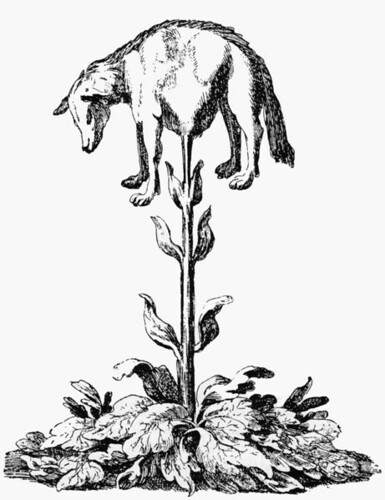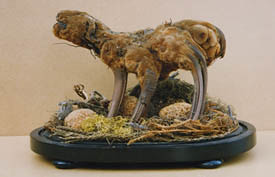Whilst researching my play Mysterium, I became fascinated by the curious theory of Spontaneous Reproduction, which, prior to our full understanding of sexual generation, was generally accepted as the prevailing wisdom. The theory held that the baser forms of life, like insects, molluscs, [and some higher forms too], emerged fully formed from the earth or other organic matters, or even from other lifeforms.
The theory spawned some extremely intriguing beliefs, many of them supported by the most prestigious thinkers of the day.
Bees could form from beads of sweat fallen from the brows of Negro slaves. Sea-anemones, in the course of time, will turn into herrings. Lions may be born of the desert sand. In a Lincolnshire village it was believed that the caterpillar of the death’s head moth will ‘in due course’ turn into a mole. Sir Isaac Newton himself ‘pointed out that plants were produced from the attenuated emanations from the tail of comets’
It is such a pity that these are not truths. They contain an innocence, a certain poetic wisdom in their perception of cause and effect which I find tremendously appealing.
Of all the manifold grotesqueries of Spontaneous Reproduction, the Vegetable Lamb or Barometz/Borometz [Tartar for ‘lamb’] is among the most curious. It’s taxonomic designation: Planta Tartarica Barometz.
The myth is ancient and first cited in the Talmud Lerosolimitanum by Rabbi Jochanan in 436AD. The story is also said to have been prevalent in the Orient in the Eleventh Century, but we learn of it more specifically in the writings of Mandeville in the Fourteenth. Though he never journeyed himself, he embraced the experiences of others as his own and, memorably, describes a particular tree bearing ‘large melon-like fruit’. Upon eating one, he discovered a fully-formed lamb within, attached to the meat of the fruit by its navel. Upon ripening, the fruit would fall and the lamb’s legs would grow into the earth like roots. Thus it had access only to that forage which lay within reach. Naturally, this sitting duck was used by the local population for meat.
Some variation of the myth exists, often describing a plant which bore the actual likeness of a lamb attached to the ground by a stalk and growing from a seed. Reaching maturity, the lamb would break from the mother plant, though an arrow could be fired at the stalk to achieve the same result. Fleeces of these creatures brought back to Europe were discovered to be the skins of lamb foetuses This version of the plant would deliberately bend low to allow the sheep to graze and, once the grass was gone, the sheep would drop like a ripe fruit and the plant would die.
I owe The Real Men Fraternity for this quote from 'Pharmaceutical Journal and Transactions' (1856). “… While in its animal nature it rejoiced in a sort of flesh and blood, browsed upon the surrounding herbs by turning round upon its axis or root, until, having devoured all within reach, it perished a victim to hunger!’
The Natural history Museum of London holds a specimen called ‘The Vegetable Lamb of Tartary’, acquired by Sir Hans Sloane, [a long-term secretary of The Royal Society]. It is in fact the rhizome of a species of fern, sculpted to resemble a lamb – to some extent, I imagine, like the guitar-fish was adapted to produce the Feegee Mermaid.
The father of modern Botany, perhaps Linnaeus, is said [in the 'Imperial Magazine, or Compendium of Religious, Moral, and Philosophical Knowledge' (1828], [again thanks to The Real Men Fraternity]] ‘to have ascertained that in the eastern part of Chinese Tartary, there is a species of fern furnished with thick tubers, which being surrounded on all sides by yellow wood, and thin chaffy scales, are often raised so high above the ground, that the roots beneath bear some resemblance to legs fixed in the soil … It is not therefore surprising that the imagination of the superstitious and ignorant should transform this curious vegetable into a voracious sheep’. [The fern, I believe, is Cibotium Barometz.]
Though it would have been difficult to lay such myths to rest, it was certainly the master-cataloguer Linnaeus in the Eighteenth Century who ‘systematically examined specimens of all the plants believed to fruit as lambs’, and found nothing in support of the Vegetable Lamb's existence.
There has been conjecture that the fruit was in fact cotton, unknown at the time, but assumed to be wool, a material with which the Western world was familiar. Since wool came from an animal, it was therefore supposed that this ‘wool-bearing’ plant must be animal in nature, and the tiny puffs of cotton lambs in miniature.
A stretch of the imagination if ever there was.
E'en round the Pole the Flames of Love aspire
And icy bosoms feel the secret Fire:
Cradled in Snow and fanned by Arctic Air,
Shines, gentle Barometz ! thy golden Hair,
Rooted in Earth each cloven foot descends
And round and round her flexible Neck she bends;
Crops the grey coral Moss and hoary Thyme,
Or laps with rosy tongue the melting Rime;
Eyes with mute Tenderness her distant Dam,
Or seems to bleat a vegetable Lamb.
from Loves of the Plants [Nineteenth Century] & Jamieson’s Dictionary [attributed to ‘the observant, but romantic' Dr. Darwin]











3 comments:
Congratulations on that brilliant post, (dificult as it was for this vegetarian to cope with) and so kind of you to see 'poetic justice' in rubbish cult theory too.
Thanks. Nice to see a picture of you Dysthymiac. I love obscurities of the past and writing about them is a principal pleasure. I'm beginning to build up material about a very peculiar ape-man legend of Biblical times.
I will never look at a Stachys byzantina the same way again.. shuddering!!
x
Post a Comment